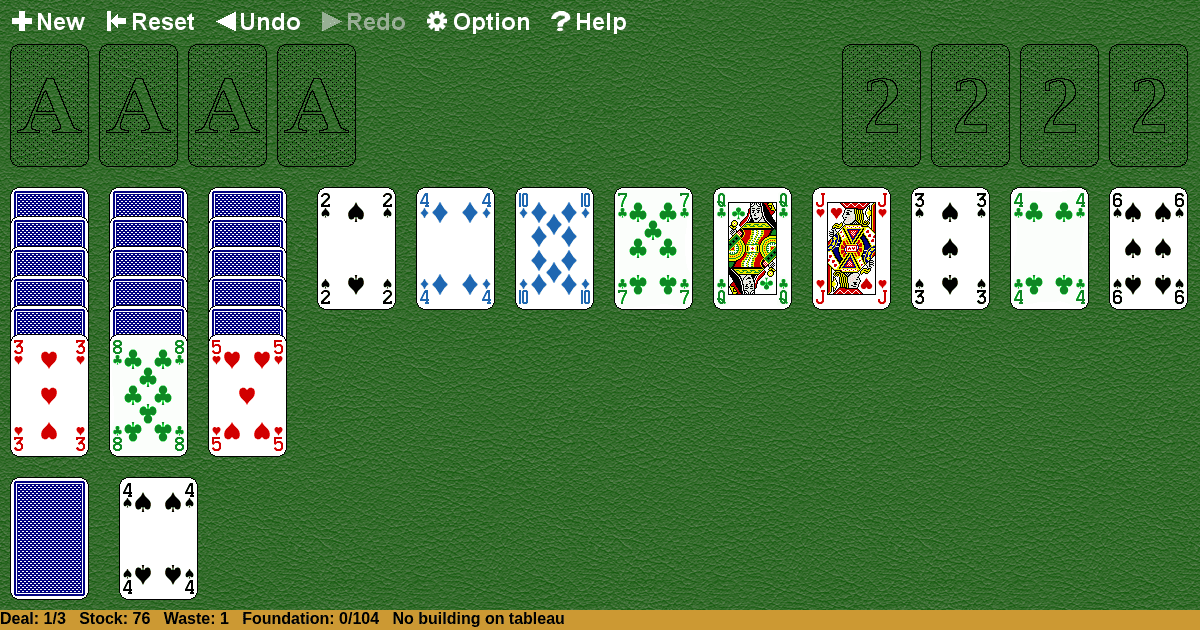Boulevard
Home |
How to play |
FAQ |
About
How to play Boulevard?
Game Objective:
The primary goal in Boulevard Solitaire is to build all cards onto the eight foundation piles. Four foundations must be built up in ascending order by twos, starting from Ace (A, 3, 5, 7, 9, J, K, 2, 4, 6, 8, 10, Q) for the left four foundations, and the other four must be built up in ascending order by twos, starting from 2 (2, 4, 6, 8, 10, Q, A, 3, 5, 7, 9, J, K), all by suit.
Setup & Layout:
- Deck: Uses two standard 52-card decks (104 cards total).
- Tableau: 9 tableau piles, each with 1 card dealt face up.
- Reserve: 3 reserve piles, each with 6 cards dealt face up.
- Foundations: 8 foundation piles, initially empty.
- Stock: The remaining cards form the stock pile, face down.
- Waste: A waste pile is used for cards dealt from the stock and not immediately played.
Key Play Areas:
- Tableau: Each pile holds only one card at a time.
- Reserve: Each pile holds up to 6 cards at the start, but cards are not replenished once emptied.
- Foundations: Eight piles where cards are built up by twos, in suit, as described above.
- Stock: Supplies new cards when no other moves are available.
- Waste: Collects cards dealt from the stock that cannot be played immediately.
Boulevard Solitaire Rules:
- Tableau Movement: Each tableau pile can hold only one card at a time. Only the card on each tableau pile is available for play.
- Reserve Movement: Only the top card of each reserve pile is available for play. Reserve piles cannot be refilled once empty.
- Foundation Building:
- The left four foundations are built up by twos in suit, starting with Ace (A, 3, 5, 7, 9, J, K, 2, 4, 6, 8, 10, Q).
- The right four foundations are built up by twos in suit, starting with 2 (2, 4, 6, 8, 10, Q, A, 3, 5, 7, 9, J, K).
- Stock and Waste: Cards are dealt one at a time from the stock to the waste pile. The top card of the waste pile is always available for play.
- Empty Tableau Spaces: If a tableau pile is empty, it must be filled immediately from the waste pile, or if the waste is empty, from the stock pile.
- Redeals: After the stock is exhausted, the waste pile may be turned over to form a new stock. This can be done twice per game (two redeals allowed).
Gameplay:
- Turn Sequence:
- Move available cards from tableau, reserve, or waste to the foundations if possible.
- If no moves are possible, deal one card from the stock to the waste pile.
- Continue making moves to the foundations or filling empty tableau spaces as required.
- Introducing New Cards:
- Cards are introduced from the stock pile to the waste pile, one at a time. Only the top card of the waste is available for play.
- No More Legal Moves:
- If no moves are possible and the stock is exhausted (and both redeals have been used), the game ends.
Winning & Losing Conditions:
- Winning: The game is won when all 104 cards are built onto the eight foundation piles in the correct order and suit as specified.
- Losing/Unwinnable State: The game is lost if no further moves are possible, the stock is exhausted, and both permitted redeals have been used, with cards remaining outside the foundations.
Special Rules & Edge Cases:
- Filling Empty Tableau Spaces: Any empty tableau pile must be filled immediately using the top card from the waste pile. If the waste is empty, fill from the stock. If both are empty, the space remains empty.
- Reserve Piles: Once a reserve pile is emptied, it cannot be refilled for the remainder of the game.
- Card Availability: Only the top card of each tableau pile, each reserve pile, and the waste pile are available for play at any time.
- Redeals: Only two redeals of the waste pile into the stock are permitted per game.
Definitions:
- Tableau: The main play area where cards are temporarily placed and manipulated.
- Foundations: The target piles where cards must be built in a specific sequence and suit to win.
- Reserve: Auxiliary piles holding extra cards, with only the top card accessible.
- Stock: The draw pile from which new cards enter play.
- Waste: The pile where cards from the stock are placed if not immediately playable.
This guide reflects the official rules and structure of Boulevard Solitaire.

Solitaire Collection
About Boulevard
Rate (Boulevard)
4.7 / 5
1,916 votes



























































